Hagia Sophia, An Architectural Marvel
Introduction

Hagia Sophia is a great architectural beauty and an important monument both for Byzantine and for Ottoman Empires. Once a church, later a mosque, then a museum and now a mosque again at the Turkish Republic, Hagia Sophia has always been the precious of its time. The Hagia Sophia is an enormous architectural marvel in Istanbul, Turkey, that was originally built as a Christian basilica nearly 1,500 years ago. The Hagia Sophia is a long-enduring symbol of the cosmopolitan city, Istanbul. However, as notable as the structure is itself, its role in the history of Istanbul—and, for that matter, the world—is also significant and touches upon matters related to international politics, religion, art and architecture. The Hagia Sophia anchors the Old City of Istanbul and has served for centuries as a landmark for both Orthodox Christians and Muslims, as its significance has shifted with that of the dominant culture in the Turkish city. It is among the world’s greatest architectural achievements, in particular famous for its massive dome, and considered the epitome of Byzantine architecture.
The History Of Istanbul’s Hagia Sophia
While the Hagia Sophia is probably not the oldest intact building in the world the Pantheon in Rome and the Basilica di Sant’Ambrogio in Milan were both built earlier – it certainly comes close. Today, the (current) Hagia Sophia is 1478 years old, and has survived hundreds of earthquakes throughout history. Its age, size, magnificence, architecture and mystical atmosphere make it truly a unique place in the world.The Hagia Sophia has always been regarded as a symbol of medieval Christian mysticism. Throughout Byzantine and Ottoman history, the building served as the Imperial Church or Mosque. Emperors were crowned here, victories celebrated and Ottoman Sultans said their prayers inside it. For many centuries, the Hagia Sophia was possibly the largest shrine in the world. Today, its dome is still accepted to hold this title of largest in the world. The church was named for an attribute of Christ, rather than being dedicated to a saint. Translated to English, ‘Hagia Sophia’ means ‘Holy Wisdom.’
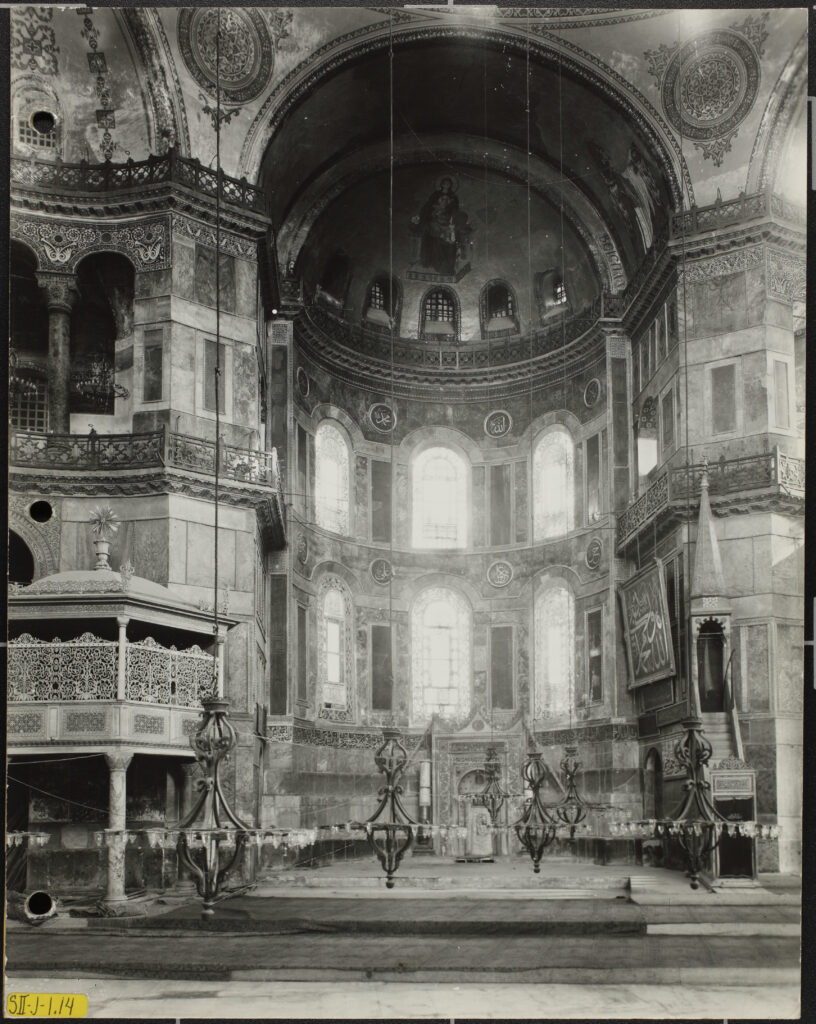
The Original Building 360 AD
Today’s Hagia Sophia is the third building to have been built on this site. The original building, constructed in 360 AD, was a basilica with a wooden roof. This original church, which also went by the name of Megale Ecclesia (Great Church), was burned down in a riot in 404. Theodosius II replaced it with a massive basilica in 415, which burned down during the Nika Revolt against Justinian in 532. Forty days after the revolt, Justinian began rebuilding the Hagia Sophia once again. Unable to repair the damage caused by the fire, Justinian ordered the demolition of the Hagia Sophia in 532. He commissioned renowned architects Isidoros (Milet) and Anthemios (Tralles) to build a new basilica. The third Hagia Sophia was completed in 537, and it remains standing today.
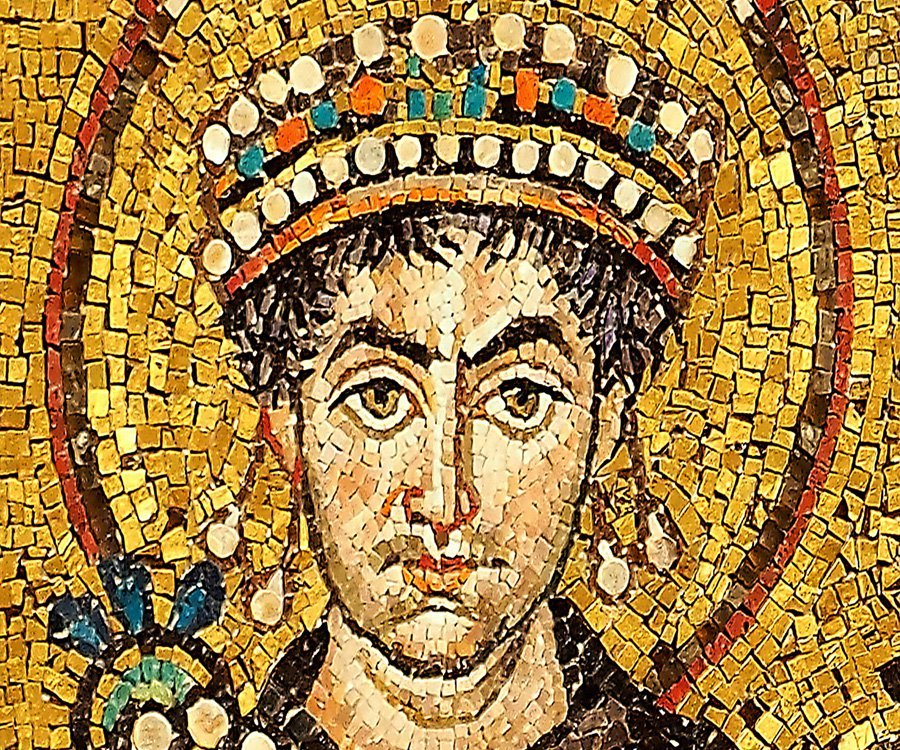
The first religious services in the “new” Hagia Sophia were held on December 27, 537. At the time, Emperor Justinian is reported to have said, “My Lord, thank you for giving me the chance to create such a worshipping place. Solomon, I have surpassed you!” a reference to the fact that Solomon’s Great Temple in Jerusalem was the largest until the third Hagia Sophia. As Greek Orthodox was the official religion of the Byzantines, the Hagia Sophia was considered the central church of the faith, and it thus became the place where new emperors were crowned. These ceremonies took place in the nave, where there is an Omphalion (navel of the earth), a large circular marble section of colorful stones in an intertwining circular design, in the floor.
The Hagia Sophia served this pivotal role in Byzantine culture and politics for much of its first 900 years of existence. However, during the Crusades, the city of Constantinople, and by extension the Hagia Sophia, was under Roman control for a brief period in the 13th century. The Hagia Sophia was severely damaged during this period, but was repaired when the Byzantines once again took control of the surrounding city.
Hagia Sophia Becomes A Mosque 1453 AD
After conquering Constantinople in 1453, Ottoman Sultan Mehmed II immediately went to the Hagia Sophia and ordered that it be converted into a mosque. This was a successful endeavor, and it has remained a mosque ever since. In the following century, the architect Sinan was commissioned to make restorations and add Islamic elements to the building. Minarets, the mihrab and the minber, were added, and appropriately positioned to face toward Mecca, 10 degrees south of the main axis of the building. Buttresses in the eastern side were added during the Ottoman period. In time, the Hagia Sophia became a complex consisting of tombs, a fountain, a library, and so on. When being used as a mosque, the mosaic panels remained, but the figures’ faces were covered. After the 18th century, the mosaic panels were covered completely.
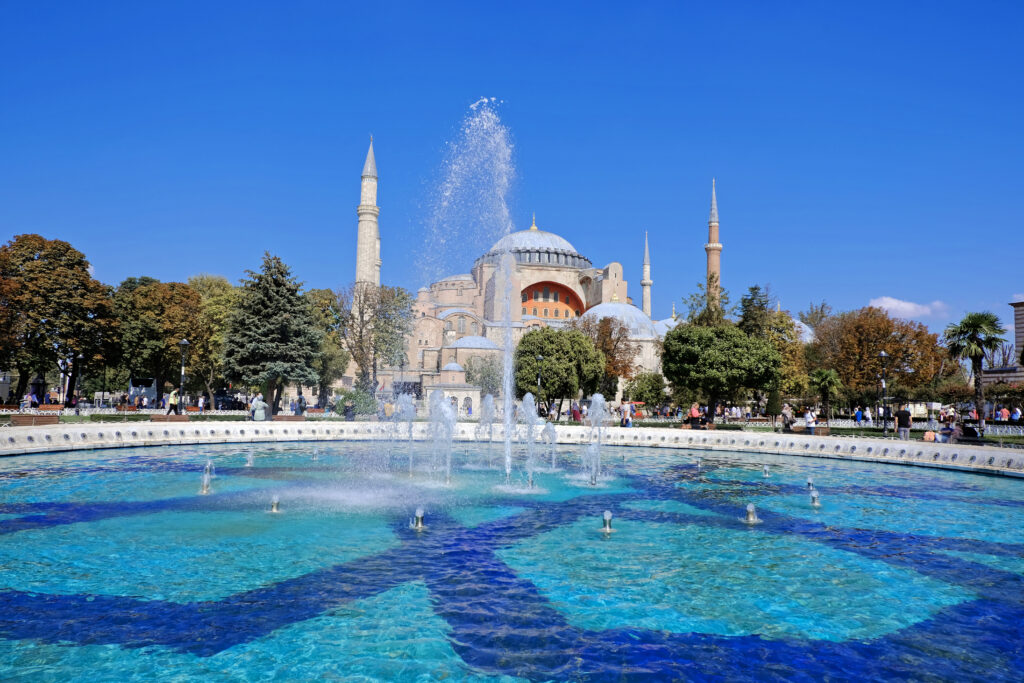
Hagia Sophia Becomes A Museum 1934
The Hagia Sophia was used as a church for 916 years and as a mosque for 481 years. In 1934, by order of Mustafa Kemal Atatürk and the decision of the Council of Ministers, it was converted into a museum and since then, has been open to visitors.
Hagia Sophia Becomes Again A Mosque 2020
Ever since the reversion of Hagia Sophia back into a mosque, the Muslim call to prayer has been resounding from its minarets. As of June 24 2020, Hagia Sophia’s icons of the Virgin Mary and infant Christ are covered by fabric curtains as the edifice yet again changes functions. The curtains covering the mosaics are on an electronic rail system and that they shall be lowered to cover the icons only during prayer times.
Images of Mary and Jesus in Islam
When Sultan Mehmed II, known as the “Conqueror” or Fatih, took over Constantinople, he headed straight to Hagia Sophia, declared it a mosque and ordered it protected in perpetuity. He did not order the ninth-century mosaic of Mary and Christ in the interior removed or covered. Instead, Ottoman historians tell us that he stood in awe, feeling that the eyes of the Christ child followed him as he moved about the structure. Although images of humans are almost never found in mosque architecture, the depictions of Mary and Jesus remained uncovered in the mosque of Hagia Sophia until 1739. At that time, the mosaic was plastered over. The plaster was later removed during the building’s 1934 conversion into a museum.
The Hagia Sophia’s Architecture
From its opening, the third and final Hagia Sophia was indeed a remarkable structure. It combined the traditional design elements of an Orthodox basilica with a large, domed roof, and a semi-domed altar with two narthex (or “porches”).
The dome’s supporting arches were covered with mosaics of six winged angels called hexapterygon. In an effort to create a grand basilica that represented all of the Byzantine Empire, Emperor Justinian decreed that all provinces under his rule send architectural pieces for use in its construction.
The marble used for the floor and ceiling was produced in Anatolia (present-day eastern Turkey) and Syria, while other bricks (used in the walls and parts of the floor) came from as far away as North Africa. The interior of Hagia Sophia is lined with enormous marble slabs that are said to have been designed to imitate moving water.
And, the Hagia Sophia’s 104 columns were imported from the Temple of Artemis in Ephesus, as well as from Egypt. The building measures some 269 feet in length and 240 feet in width and, at its highest point, the domed roof stretches some 180 feet into the air. When the first dome suffered a partial collapse in 557, its replacement was designed by Isidore the Younger (the nephew of Isidoros, one of the original architects) with structural ribs and a more pronounced arc, and this version of the structure remains in place today.
This central dome rests on a ring of windows and is supported by two semi-domes and two arched openings to create a large nave, the walls of which were originally lined with intricate Byzantine mosaics made from gold, silver, glass, terra cotta and colorful stones and portraying well-known scenes and figures from the Christian Gospels.
What is so fascinating about Hagia Sophia’s architecture?
Imagine an architectural masterpiece that dates back to the 6th century which has been used first as a church, then a mosque and finally a museum. It’s become one of the leading artistic and architectural monuments in the world therefore attracting not only the tourists but also the historians, the architects, the artists and the archaeologists. Hagia Sophia plays an important role in the world of art due to its architecture, magnificence, grandness and functionality.
The transformation of the monument in years can be considered as unique in the world. It was transformed, developed, affected by the historical, political and religious changes of the area where it is located from the 6th century till today. When it was built, today’s Istanbul was Constantinople then, which was the capital of the Byzantine Empire.
The purpose of the building was to worship and it has carried on its purpose for hundreds of years, first by the Christians then by the Muslims. It was built as a Cathedral reflecting Christian architectural features but then after the conquest of the Ottoman Emperor Fatih Sultan Mehmed it was turned to a mosque by adding Islamic features like minaret, a chandelier, mihrab and a minbar without destroying the features of the Christian church. Not touching the Christian features of the monument and adding Islamic features make this monument a unique architectural masterpiece.
Hagia Sophia Dome
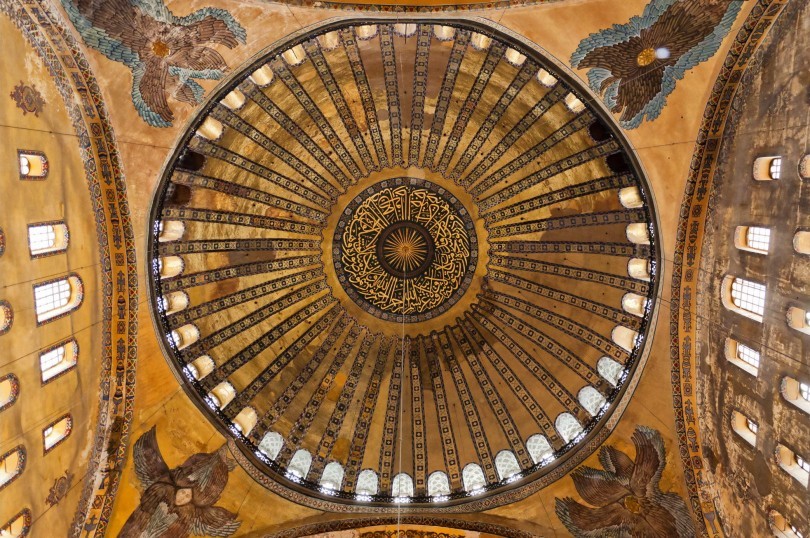
It is mostly the dome which makes Hagia Sophia world famous. Hagia Sophia dome sits at the centre of the church. It is between two half domes which together equals to the diameters of the dome. The first dome built by Anthemius & Isidorus was planned as a circle. However; it turned out to be an ellipse. When the dome collapsed mostly during on earthquake in 558, Justinian commissioned Isidore the Younger whose structurally deformed work of art survives still today. The dome is built by brick and mortar, it is 31, 24 mt (102 ft 6 in) diameters and is 55, 6 mt (182 ft 5 in) high. Because of the several repairs and constructions in time, the dome lost its circular shape and the diameter became 31,24 mt (102 ft 6 in) to 30,86 mt (101 ft 3in). Hagia Sophia Dome is carried on four pendentives and these pendentives enable its transition into the square shape of its piers below. These pendentives distribute the weight of the dome to the walls under it. The sunlight which floats all around the church and shines upon the gilded mosaics enters mostly from the forty windows encircling the base of the dome. The windows are not only a source of light but also an alarm of a breakdown in the dome. They also relax the pressure of the dome on the pendentives
Loge of Empress
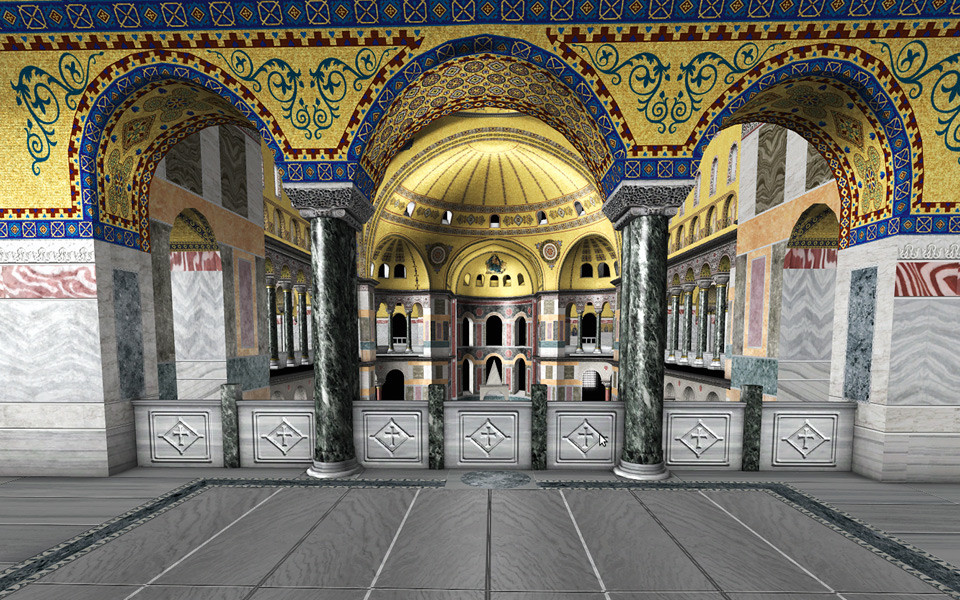
Empress’ loge is on the west upper gallery, overlooking the nave from the top. From there, the Empress could watch the rituals and ceremonies.
Muezzin’s Loge

There are five muezzin’s loges in Hagia Sophia. The first one, located on the east of the main place was built by Sultan Murad III in the 16th century. The loge was used by the muezzins who call to prayers.
Omphalion
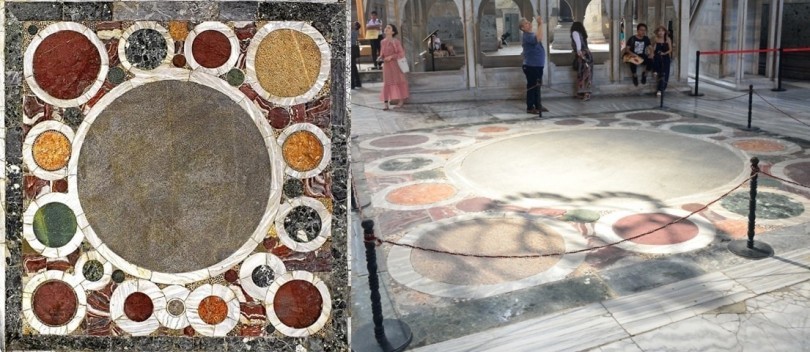
Omphalion, which literally means ‘’little omphalos’’ (navel of earth), is an opus sectile panel in Hagia Sophia. It consists of 32 rotae of different size of marbles, including red & green porphyry, green and pink granite ones. It is located just in the middle of south-eastern quarter of the square under the dome. It was used to crown the Byzantine Emperors.
Marble Door
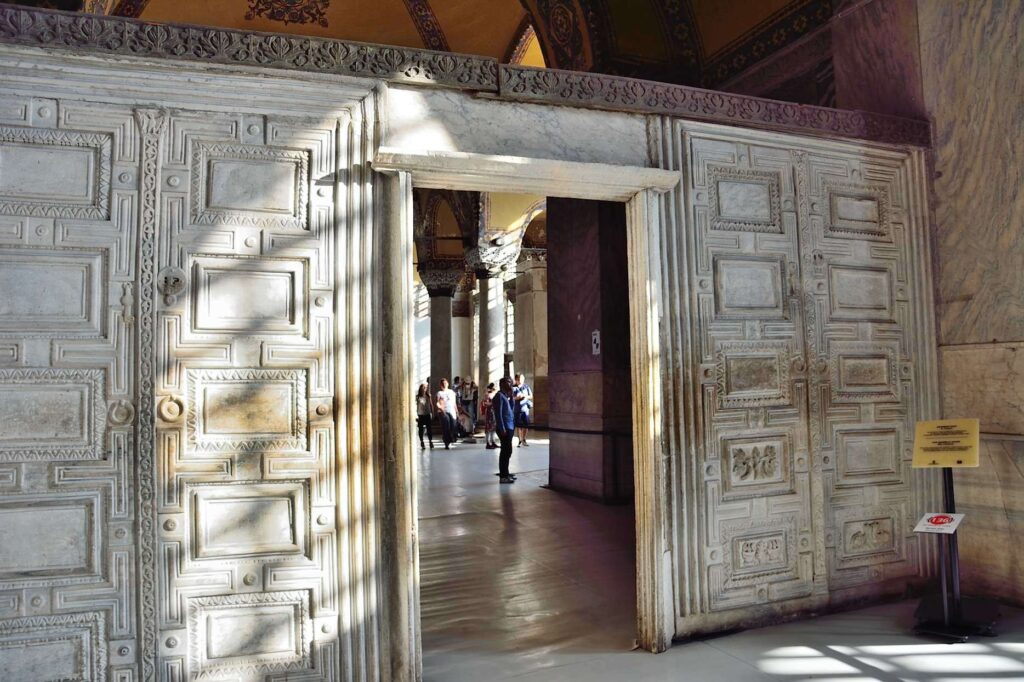
Located near the Empress Lodge in Hagia Sophia, the door of Heaven and Hell (Marble Door) is a door made of marble. The door used to separate the west and south galleries. It is probably removed from another Hellenistic building and was brought to Hagia Sophia. The marble door was used by synod members to enter and exit to the meeting chamber. There are depictions of fruit & fish. The room was used by the priests for their religious meetings. It is said that the room also housed the Synod Council in 1166 and the decisions taken by them were displayed on marble tablets on the walls of outer narthex.
Narthexes
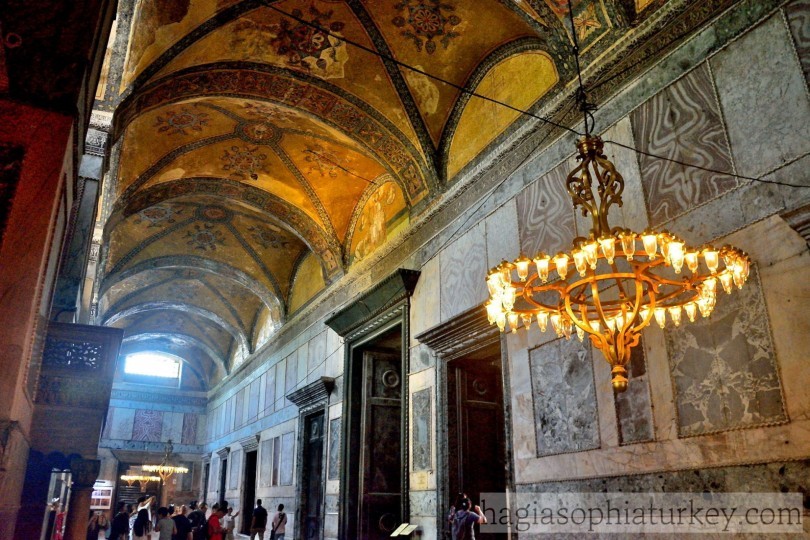
In Hagia Sophia, there are two narthexes, the inner narthex and the outer narthex. Narthexes used to prepare the believers to spiritual world as they were entering the holy place. There was an atrium with five gates before the outer narthex originally. The emperor would come through the Beautiful Gate (Orea Porta) and the weepers would be allowed to stay in the narthexes.
Sultan’s Lodge
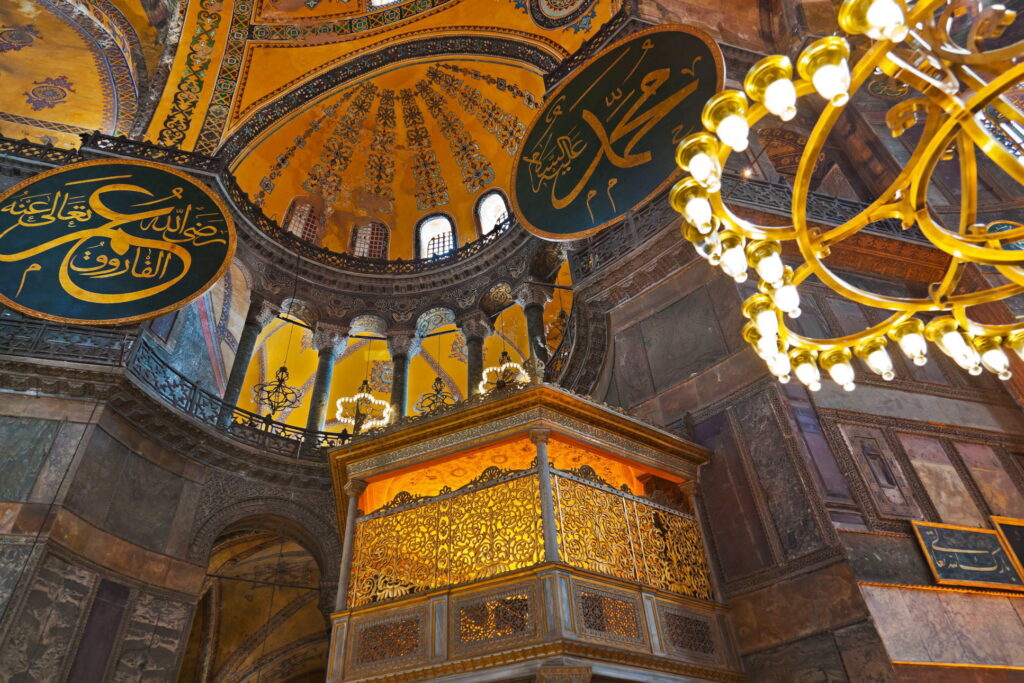
The earlier lodge was located on the apse, but Gaspere Fossati designed the new lodge in 1847 and replaced it against the pier to the north of the apse. The lodge was used by Sultan to join the rituals without being seen by public and it was also to protect the Sultan from possible assassins. The grills of the lodge are carved marble in Turkish rococo style, and the columns carrying the lodge are Byzantine.
Calligraphic Roundels
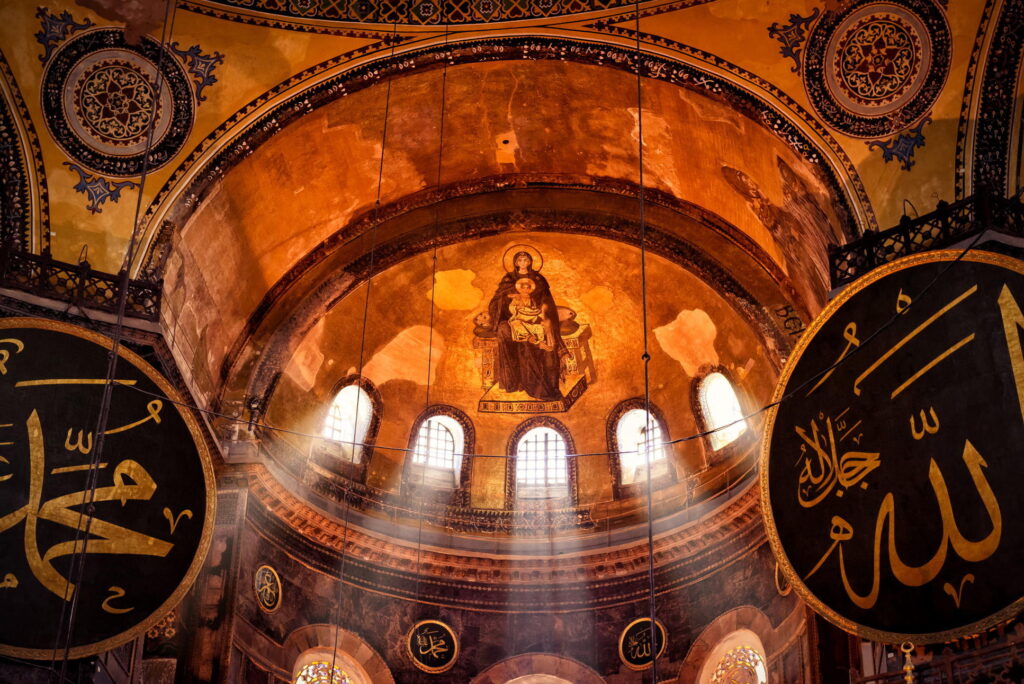
Inscripted by M. ‘’Izzet Efendi’’, the eight calligraphic roundels of Hagia Sophia were placed by Fossatis during the Sultan Abdulmejid reign. The huge wooden panels bear the names of Allah, Mohammed and his grandsons; Hasan & Hussein and four caliphates. They intended to remove them when the mosque was converted into a museum. However, they couldn’t go through the doors.
Emperor Door
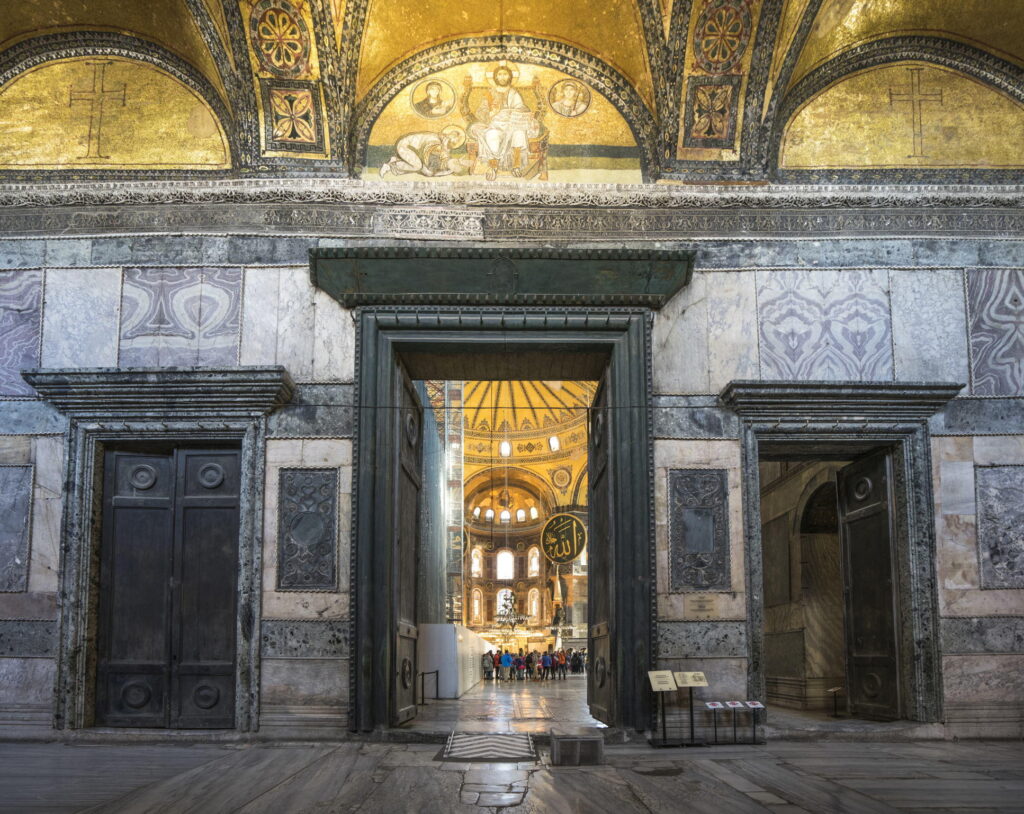
In Hagia Sophia, three doors of outer narthex which symbolize the Holy Trinity give way to the outer narthex with 5 doors. From there nine gates lead to heart of the church. The largest (7 meter heigh) door is made of oak and has a bronze frame. It is the most magnificent door among the doors of Hagia Sophia, which were up to 40 in Byzantine times. The Emperor Door is believed to have been made of the woods from Noah’s Ark. Above the door, it’s found a metal box attributed as a coffin. According to legend a Byzantine Empress who was afraid of shakes wanted to be buried in a metal coffin. However, her last will seems to be in vain because of the holes on it. On the coffin, you can see also a relief of a bird on a throne and an open passage from Gospel.
Mahmut I’s Library

Mahmut I who reigned between 1730- 1754, gave strong interest in Hagia Sophia. He ordered repairs, and also he added a library, a fountain, an imaret ( a kitchen to serve food for poor) and a school for children to Hagia Sophia. The library is located on the first floor of Hagia Sophia at the southern aisle. It is a rectangular room, half of the walls decorated with marble and half top with iznik tiles. On the east wall hangs the “tugra” (calligraphic signature) of Mahmut I. The library’s front side has six columns, and in between there are bronze grills that closes the interior.
Columns
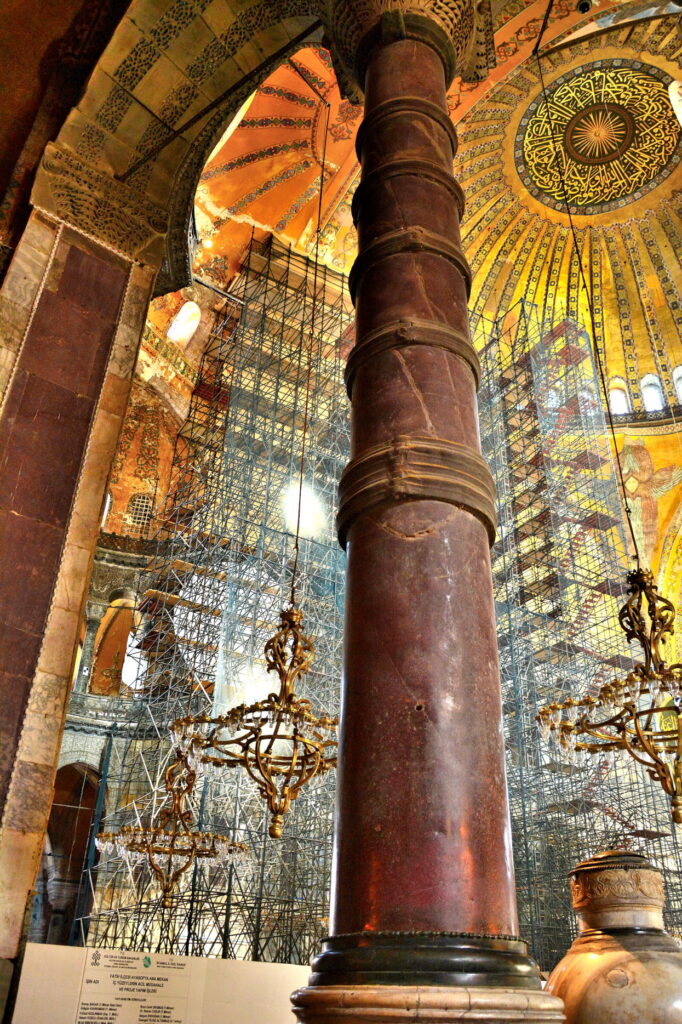
In Hagia Sophia, there are 140 monolithic columns which were brought from different places of the world. For instance; the 8 porphyry columns whose color of purple symbolize nobility of the Byzantine Empire, are from Egypt and stand under semi domes. There are also 8 green columns from Artemis Temple in Ephesus. The capitals of the columns are carved with acanthus and palm tree leaves and the monograms of the emperors (Justinian & Theodora) appear on them. None of the bowl capitals are identical.
Marble Jars

Each of them carved from single blocks of marble, alabaster urns date from Hellenistic times. Found by a peasant as he was ploughing his field in Pergamon, the marble jars were full of gold. The peasant came to Sultan Murat III to tell him he found three marble jars in his field. Sultan brought two of them to Hagia Sophia and granted him the third jar and the field in which he found them. He is also said to have required the soldiers to empty the jars because Sultan wanted only the jars not the golds. After adding a tap and a lid on them, the urns were used to take ritual ablutions in the Hagia Sophia.
Renovations to the Hagia Sophia
As Islam was the central religion of the Ottomans, the Hagia Sophia was renovated into a mosque. As part of the conversion, the Ottomans covered many of the original Orthodox-themed mosaics with Islamic calligraphy designed by Kazasker Mustafa İzzet.
The panels or medallions, which were hung on the columns in the nave, feature the names of Allah, the Prophet Muhammad, the first four Caliphs, and the Prophet’s two grandsons. The mosaic on the main dome—believed to be an image of Christ—was also covered by gold calligraphy. A mihrab or nave was installed in the wall, as is tradition in mosques, to indicate the direction toward Mecca, one of the holy cities of Islam. Ottoman Emperor Kanuni Sultan Süleyman (1520 to 1566) installed two bronze lamps on each side of the mihrab, and Sultan Murad III (1574 to 1595) added two marble cubes from the Turkish city of Bergama, which date back to 4 B.C. Four minarets were also added to the original building during this period, partly for religious purposes (for the muezzin call to prayer) and partly to fortify the structure following earthquakes that struck the city around this time. Under the rule of Sultan Abdülmecid, between 1847 and 1849, the Hagia Sophia underwent an extensive renovation led by Swiss architects the Fossati brothers. At this time, the Hünkâr Mahfili (a separate compartment for emperors to use for prayer) was removed and replaced with another near the mihrab.
The Facts and Secrets of Hagia Sophia
At his new novel Inferno, Dan Brown’s protagonist Iconographer Robert Langdon reveals to Sienna Brooks – a young genius doctor- “we are in the wrong country”, and starts following the clues that would take him to Hagia Sophia to solve the secret and to save the world.
Being an important world heritage, 1500 years old Hagia Sophia became the inspiration to many discussions, books, movies and films with a lot of mysteries yet still waiting to be uncovered. At the end of the novel Inferno, we will learn if Professor Langdon will be able reveal the secrets of Hagia Sophia. A part from the novel, what makes Hagia Sophia so mysterious?
The Secrets of Hagia Sophia
Viking Script

In the upper South gallery, a Viking Script which dates back to the 10th century is still can be seen. A sentence is inscripted on the marble with runic letters: ‘’Halvdan was here.’’ This script isn’t unique in Hagia Sophia. There are about five other writings done by the Vikings. What on earth a Viking does in Constantinople and even Hagia Sophia?
When Swedish Vikings made their way to Russia in the 9th century for trading, they established a quick relationship with Slavs. They married them and got the name ‘’Rus’’ as a Nordic Slavic nobility. This community chose ‘’Varangians’’ who were Viking warriors from the North to trade. Varangians preferred invading Byzantium first. However, when they couldn’t achieve it, they established a business connection with Byzantium. Later, Byzantines hired them as mercenaries. In time, they fought against Turks, Arabs and even Catholics in the Crusades. Moreover, Varangians of Constantinople converted to Christianity and found a place in the Imperial Army until the end of the empire in 1453.
The Sweating Column
Located at the northwest exit of the nave, the sweating column stands. There is a hole on the column which is covered with bronze. It has been rumored that the column performs miracles. People put their thumbs inside the hole and twist their hand 360 degrees. If you feel went on your finger, it’s said that your wish will come true.
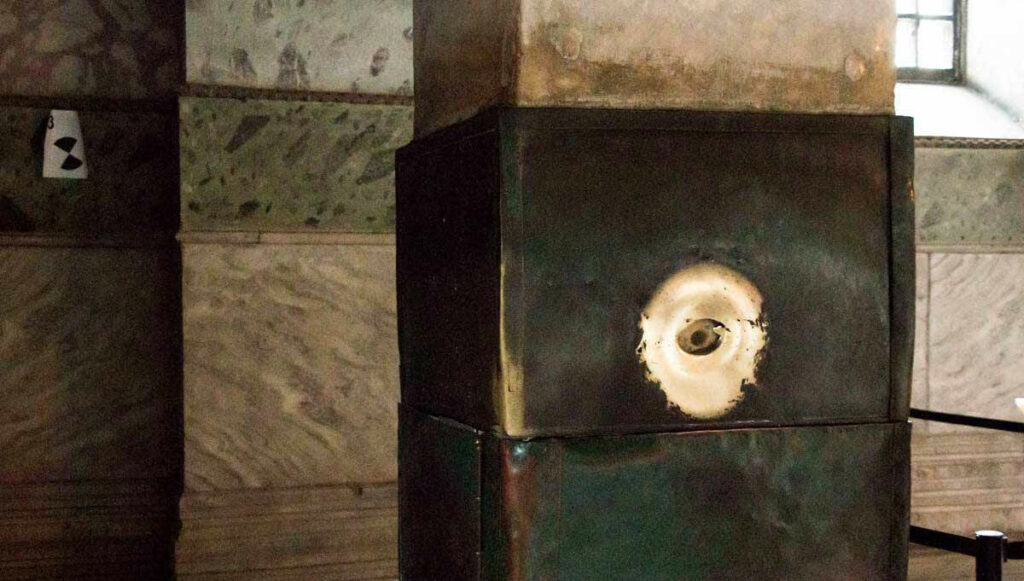
Metal Coffin Legend
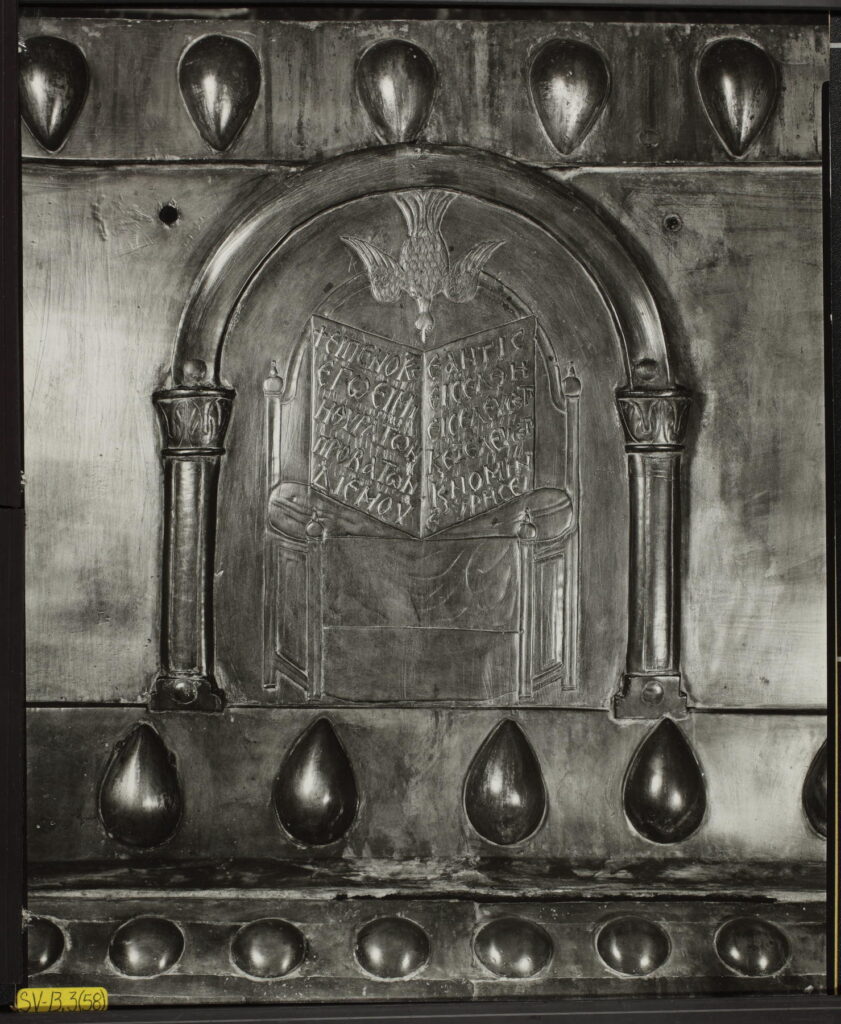
The Emperor Constantine had a daughter whom he loved very much. One day, the emperor called all his daughter’s future. The oracles told him that his daughter would be stung to death by a venomous snake’s bite on her 18th birthday. The emperor, in an effort to prevent his daughter’s early demise by placing her away from land so as to keep her away from any snakes, had the tower built in the middle of the Bosphours to protect his daughter until after her 18th birthday. After a while, he sent his much beloved daughter to that tower. The days of the princess were passing in this tower. One day, the girl wanted to eat grapes. Whereupon, a basket of grapes had been brought to her. Upon reaching into the basket, however, a snake that had been hiding amongst the grapes bit the young princess and she died in her father’s arms, just as the oracle has predicted. Emperor Constantine had an iron coffin made for her daughter so that she would be protected from sankes after her death and placed it on the entance gate of Hagia Sophia. However, today, the two holes o the coffin in the same place she was bitten show that the snake disturbed her after her death as well.
Tunnels of Hagia Sophia
Hagia Sophia keeps its secrets. With the documentary “Beneath the Hagia Sophia”, the myth of Hagia Sophia becomes a popular subject. But what are those legends? The divers’ team for the documentary searched the legend and the reality. To the legend, Hagia Sophia was important as Vatican. There were tunnels reaching to Princes Islands (Kinaliada) starting from Hagia Sophia. The underground tunnels covered the city of Constantinople. The huge cistern that a galley may sail was beneath earth. The tunnels under Hagia Sophia were reaching to Crypto rooms and the rooms for secret writings. The treasures were hidden beneath Hagia Sophia due to the sieges.
There was no certain information about any burial beneath Hagia Sophia. The divers revealed some graves under Hagia Sophia, St. Antinegos, the first person to be buried in Hagia Sophia from the 13th century, and Patriarch Athanasius– both the reality beyond the legend. The team reached two narrow corridors of about 70 centimeters height through Sultanahmet Square and Topkapı Palace, possibly were used by the Byzantine Emperor Theodosius II in the 5th-century as a hidden tunnel in order not to be seen by the public. Any trace of such legendary long tunnels or secret rooms is still a question after the permission taken just for one day. Yet, there are places to be discovered.
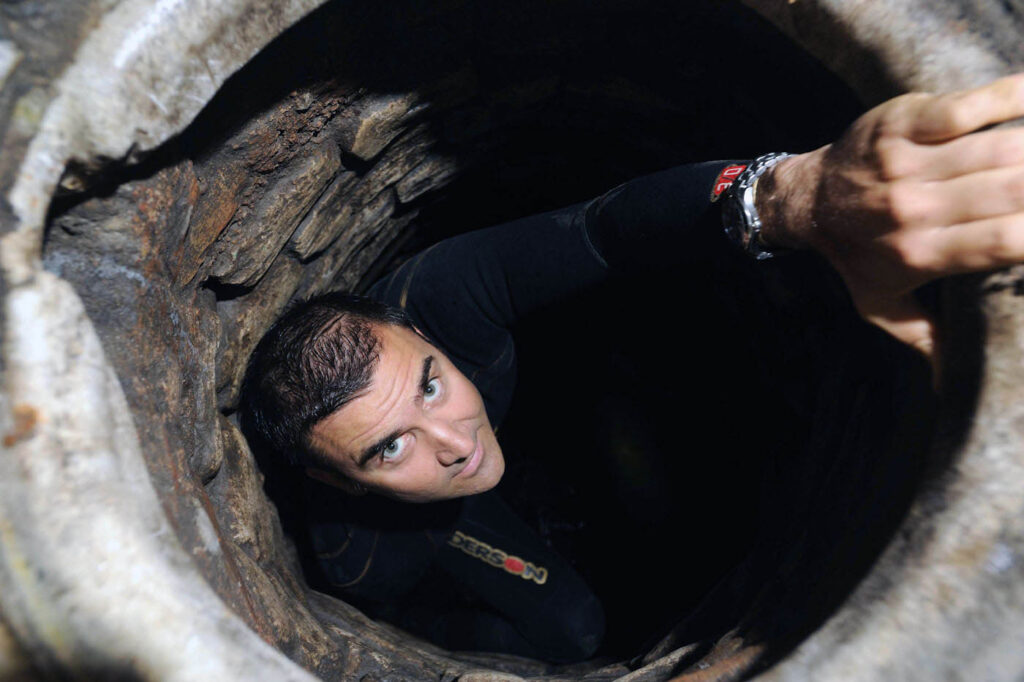
Goksel Gulensoy tried to reveal the hidden secrets of Hagia Sophia lying beneath the surface in his new documentary. He with his team of two divers and four spelunkers dived to learn more about the reservoirs which are connected to Topkapi Palace and Underground Cistern. The first to explore was the reservoir close to the entrance. It is 12 meters deep and the divers found two thick pieces of wood and a bucket which turned into dust when they were touched. In the second reservoir they found a dozen flasks dated 1917, glass from the chandeliers, a chain with two rings at the end and pieces of stained glass. Although he has started his studies back in 1998, he could complete his 50 minute documentary In the Depths of Hagia Sophia in 2009.
As the Ministry of Culture prohibits any change beneath the structure, the idea of tunnel entrances that might have closed in time may still a possibility, and, therefore, the legend may still continue.
160 years old secret
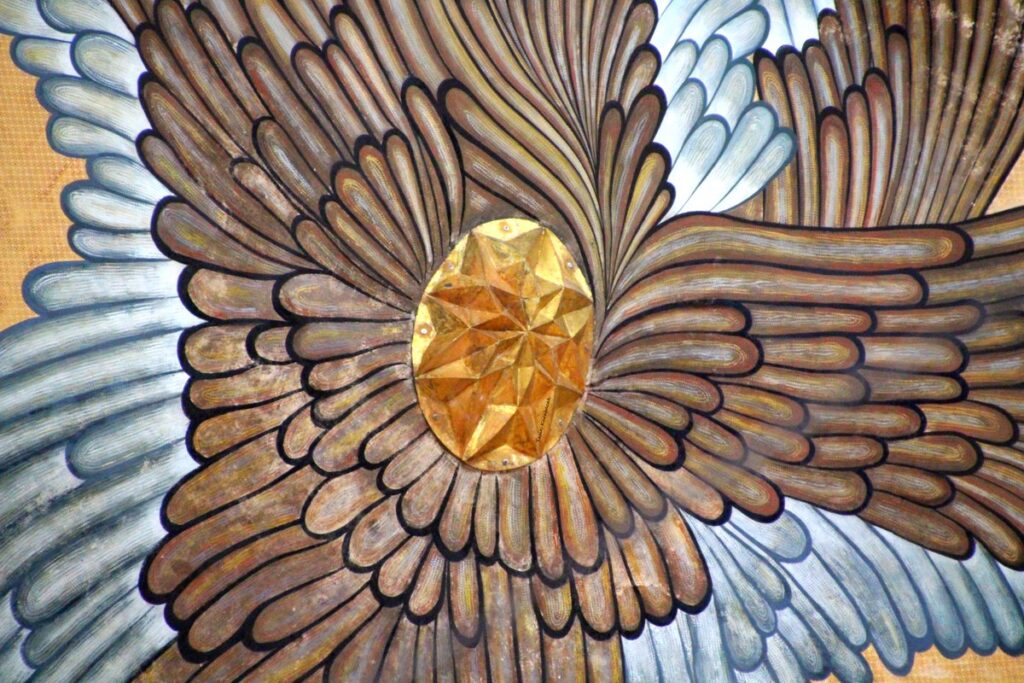
After 160 years of darkness, Seraphim’s face is in daylight. There are 4 seraphim mosaics (God’s protector angels with 6 wings) on the 4 pendentives that carry the dome. The 4 seraphims’ faces were covered with 6-7 layers of plaster for almost 160 years during the sovereignty of Ottomans. The last person who saw the faces of the Seraphim was the Swiss architect Gaspare Fossati while he was holding the restoration at Hagia Sophia in 1840s. With a 10-day hard work, experts managed to take off the 7 layers of plasters and reveal the face of one of the seraphim. The 16 years old scaffold that was standing on the southeast quarter of the dome for reconstruction purposes has been unstitched to be set up to northeast quarter. The certain age of the mosaics is unclear however they are known to be older than 700 years.
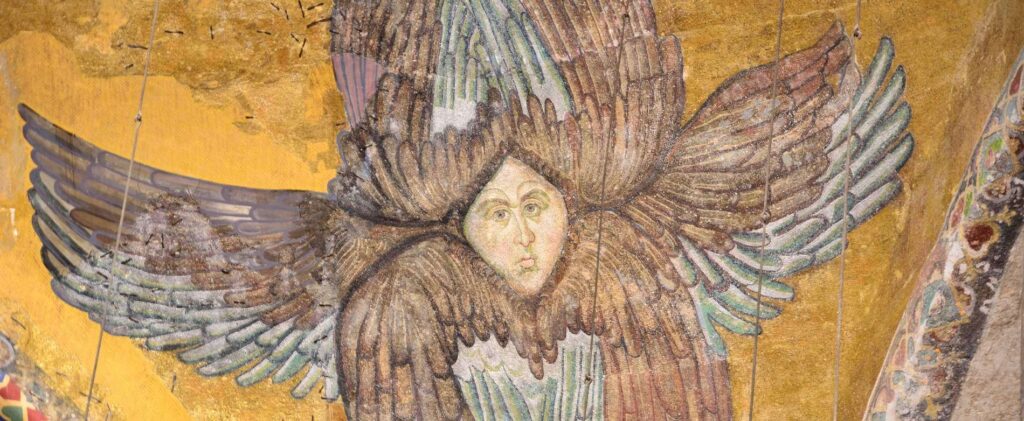
Gli the Cat of Hagia Sophia
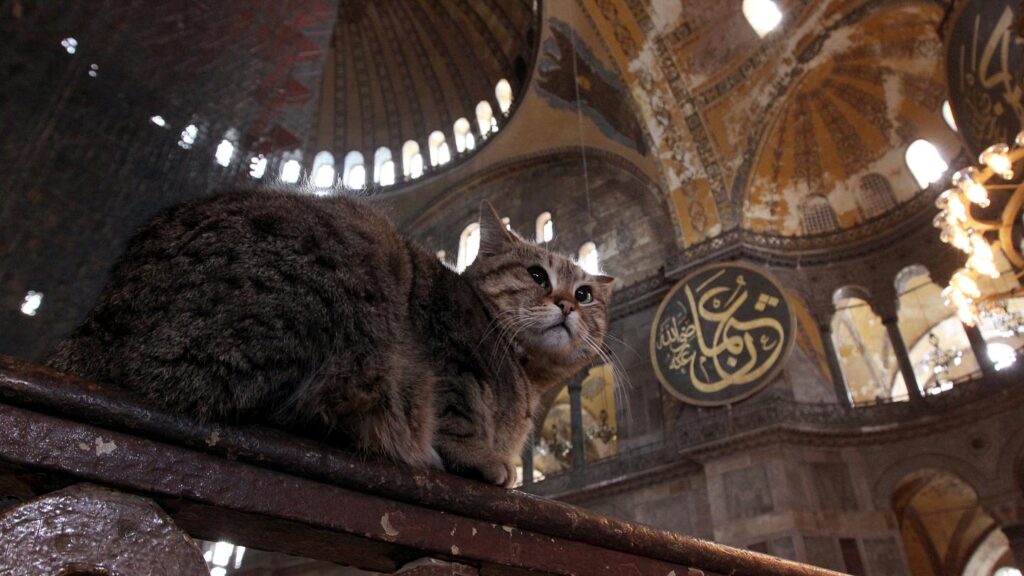
The name of this love is Gli “Union of Love” and here comes the life story of Gli: Archeologist Defne Bali who has worked for Hagia Sophia for years was like a mother to Gli. Gli became popular when the prime-minister R.Tayyip Erdoğan and then Obama stroked her. She passed away recently at the age of 16 (Oct 2020).
Some Facts about Hagia Sophia
- Sophia means Wisdom in Greek Language. When we translate the full name of Hagia Sophia to English it is Shrine of The Holy of God.
- Hagia Sophia was dedicated to Logos who was the second person in the Holy Trinity, in December 25th.
- There were two more Churches accepted as Church of Holy Wisdom, but only Hagia Sophia was not destroyed.
- The Alter, the bells, sacrificial vessels and iconostasis were all removed when the church was converted into a mosque.
- When Hagia Sophia was a church 50 foot silver iconostasis was decorating inside
- Only Patheon in Rome has slightly bigger dome than the dome of Hagia Sophia in the world.
- Eastern Orthodox Church focused on Hagia Sophia for 1000 years as an important place.
- The Blue Mosque and Sultan Ahmed Mosque in Istanbul were designed with an inspiration of Hagia Sophia.
- Hagia Sophia as a museum has both Christian and Islamic influences and features today.
- Hagia Sophia has 40 windows in the area where worshipers sit and it’s known as famous reflecting mystical light.
- When the dome of Hagia Sophia was placed, walls began to lean outward because of the weight. Then walls to support to dome were built.
- A mathematician, a Scientist and a physicist designed the Hagia Sophia.
- Many Christian mosaics and frescoes were plastered over when Hagia Sophia converted in to a mosque by Sultan Mehmed II.
- Hagia Sophia is visible from far miles distances because of its grandness.
- The stone cannonballs, which were used by Mehmet the Conqueror, are on display near the entrance of Hagia Sophia.
- Hagia Sophia was constructed over fault line and earthquake can tear the structure down. It must be strengthened with some works. Some repairs in Hagia Sophia are going on today but definitely need more financing.
- Hagia Sophia is the only building in the world that served to three religions in order ; Pagan, Christian Orthodox and Sunni Islam.
- Hagia Sophia was built by the order of the Eastern Roman emperor Justinian at the 6th century AD on top of a pagan temple.
- Relics such as nails from the true cross and the shroud of Mary were some of the very important treasures of the church until the attack of the crusaders.
- There are large cisterns under the building which is described by historians big enough for a boat to fit in. Those cisterns are also believed to connect to other cisterns located under the seat of the sultan.
- It is believed that underground sections of the building like cellar, chambers or cyrpts were concealed by the priests of the church at the time of the Ottoman invasion to hide and keep the relics.
Hagia Sophia Mosaics
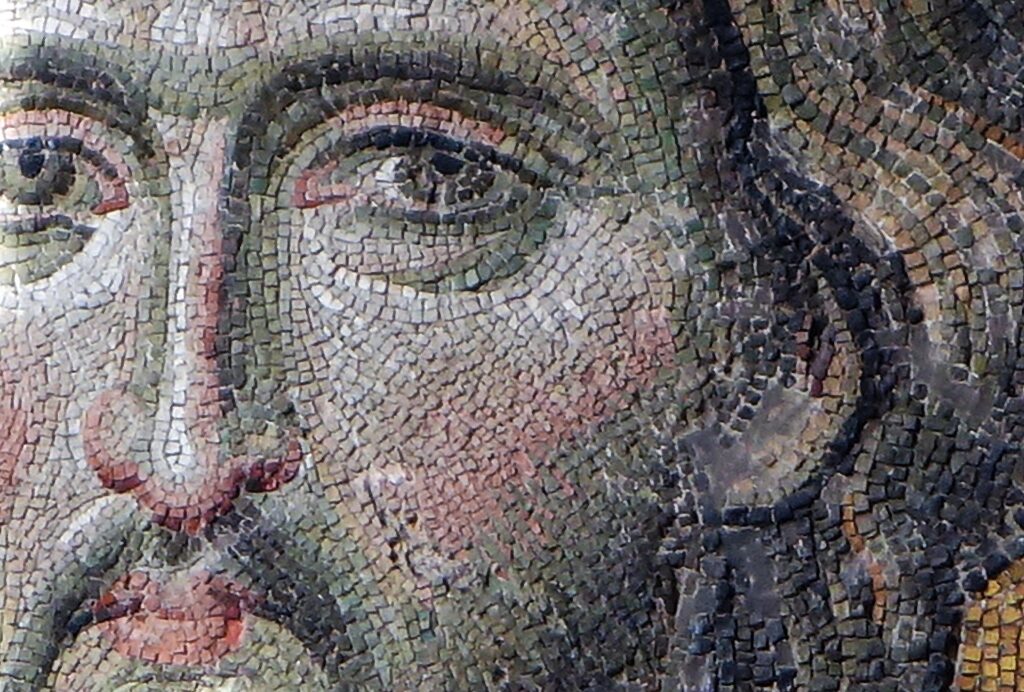
Hagia Sophia was beautifully decorated with mosaics within the centuries during Byzantine period. These mosaics depicted Virgin Mary, Jesus, saints and emperors or empresses. The history of the earliest mosaics is unknown as many of them were destroyed or covered during Iconoclasm. The known ones start from the reestablishment of orthodoxy and reach its height during the reigns of Basil I and Constantine VII. During the fourth crusade in 1204, Latin Crusaders sacked many Byzantine buildings including Hagia Sophia. Many beautiful mosaics were removed and shipped to Venice. After the Ottoman occupation of Constantinople in 1453, with the transition of Hagia Sophia into mosque, the mosaics were covered whitewashed or plastered. With Fosatti brothers’ restoration in 1847, the mosaics got uncovered and were copied for record. But they still remained covered until 1931 when a restoration and recovery program began under the leadership of Thomas Whittemore. However, many of the great mosaics that Fosatti brothers recorded had disappeared probably with the earthquake in 1894.
Imperial Door Mosaic
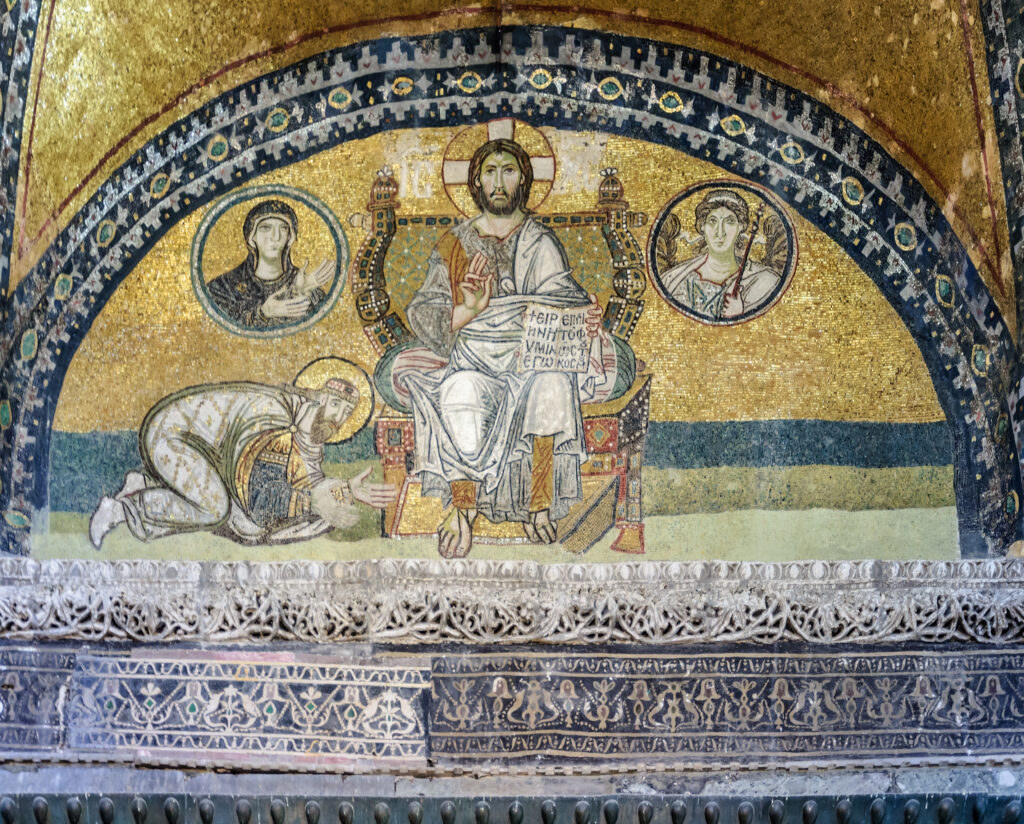
It is located on the tympanum above the imperial door leading to the narthex. This door was used only by emperors, and it was the most splendid entry to the church. The mosaics date back to 9 or 10th century. Emperor Leo VI with a halo over his head is giving proskynesis, an act of respect – to Christ, who is sitting on a jeweled throne. With his right hand, Christ is blessing the emperor, and his left hand is holding a book written “Peace be with you. I am the light of the world” on it. On both sides of Christ, there are figures in the roundels. One of them is His Mother Mary and the other is Archangel Gabriel. This image is intended to show the timeless power of emperor and his subjects blessed by Christ.
Southwestern Vestibule

The entrance to Hagia Sophia from the south entrance is through a bronze gate to the vestibule with a doorway to the narthex. The mosaic is in the tympanum over the doorway and is dating back to 944. Virgin Mary is sitting on a backless throne decorated with jewels. Child Christ is sitting on her lap and he is holding a scroll. They are both flanked on the left by Justinian I, and on the right by Constantine the Great. Both emperors are in their Byzantine ceremonial dress. Emperor Justinian is offering a model of Hagia Sophia to Virgin Mary, and Emperor Constantine is offering a model of the city, the city that he had made his imperial’s capital giving his name after it. The mosaic presents the connection between the church and the empire and the church as the seat of imperial ritual.
North Tympanum
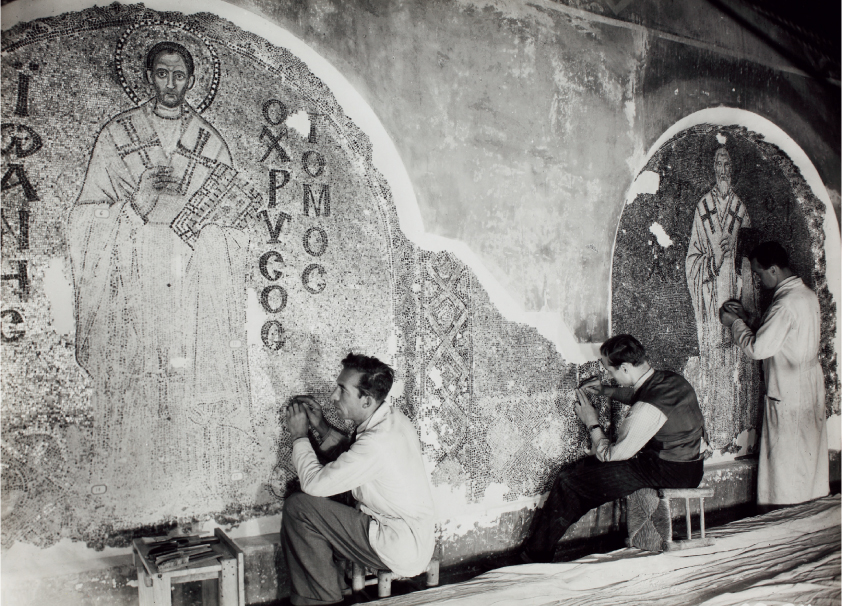
These mosaics are located on the left balustrade above the upper gallery, below the two rows of windows of the tympanum. They depict John Chrysostom and Ignatius the Younger. They both do blessing with their right hands while carrying the holy bible on their left hands. Nothing left from the mosaics at the opposite tympanum probably due to earthquakes.
Apse Mosaic
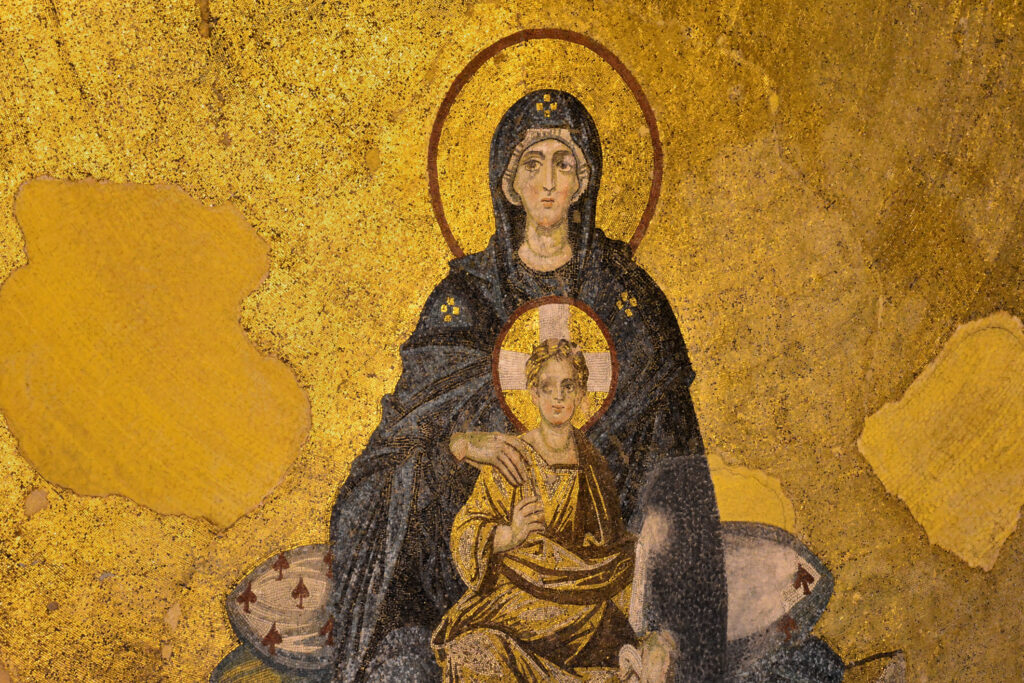
Located at the east end of the church, at a high point in the apse, it depicts Virgin Mary sitting on a backless throne decorated with jewels, and holding child Christ on her lap. On 29 March 867, patriarch Photius inaugurated the mosaic. The image was possibly damaged and destroyed before and restored heavily in the 14th century, the golden background is the original remaining from the 9th century.
On each side of the image stand archangels Michael and Gabriel. Michael is largely destroyed but Gabriel mostly remains.
Emperor Alexander
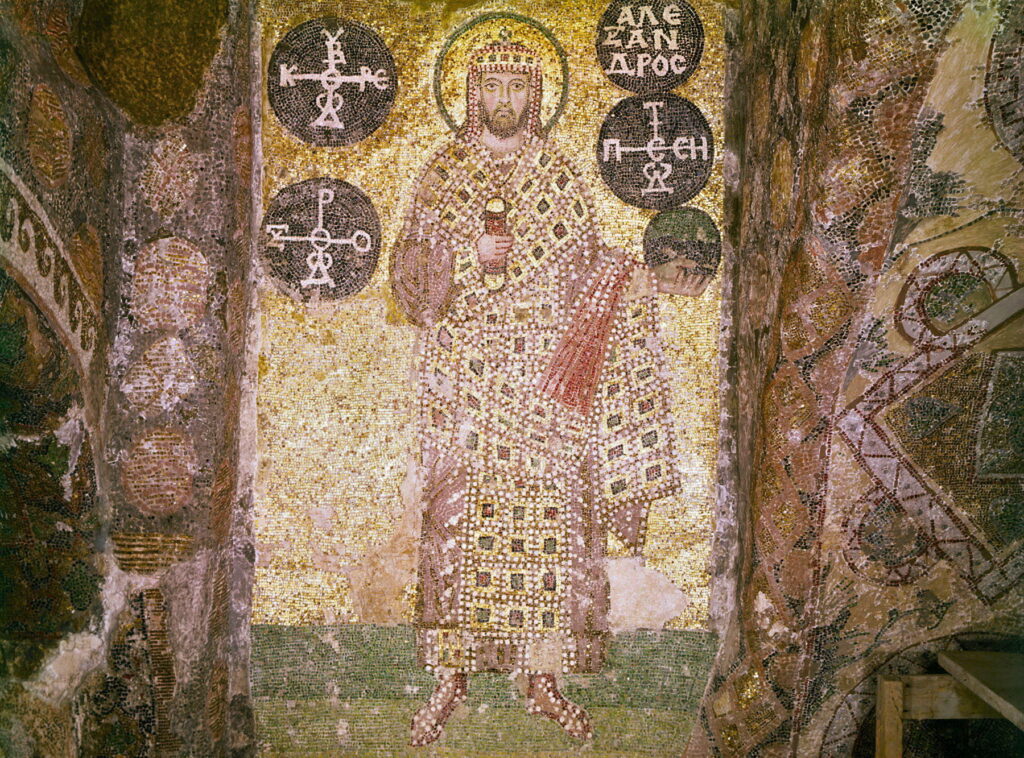
This mosaic at the upper north gallery is on a dark and high corner and is difficult to see for the first time visitors. It dates back to 10th century, and probably had been made during emperors own reign on 912-13. Emperor Alexander is wearing a ceremonial Byzantine dress and the camelaucum, an imperial crown. He is holding a scroll with his right hand.
Empress Zoe
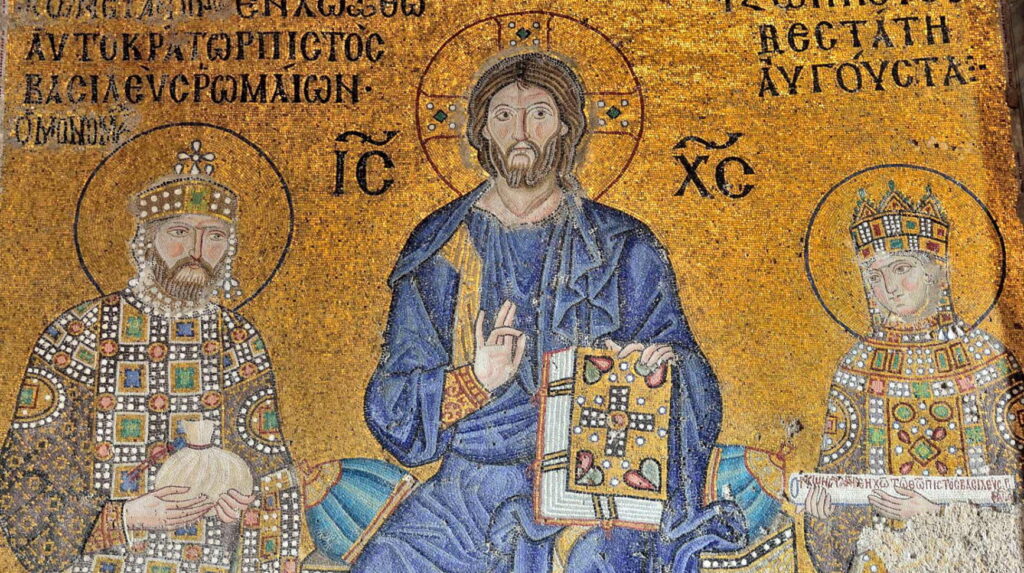
Located at the upper south gallery on the eastern wall, the mosaic is dating back to 11th century. Jesus Christ is sitting on a throne decorated with jewels. He is wearing a dark blue robe, blessing with his right hand, and holding the bible with his left hand. On his left stands Empress Zoe, offering a scroll that symbolizes the donations she made to the church. The face of her consort is believed to have changed three times according to her two previous husbands. Now is the face of her final spouse Constantine IX Monomachus. They are both in their formal dresses. Emperor Constantine IX is offering a purse, a symbol for his donation to the church. On the text below him is written “Constantine, pious emperor in Christ the God, King of the Romans, Monomachus” and the text above the head of the empress says “Zoë, the very pious Augusta”.
Comnenus
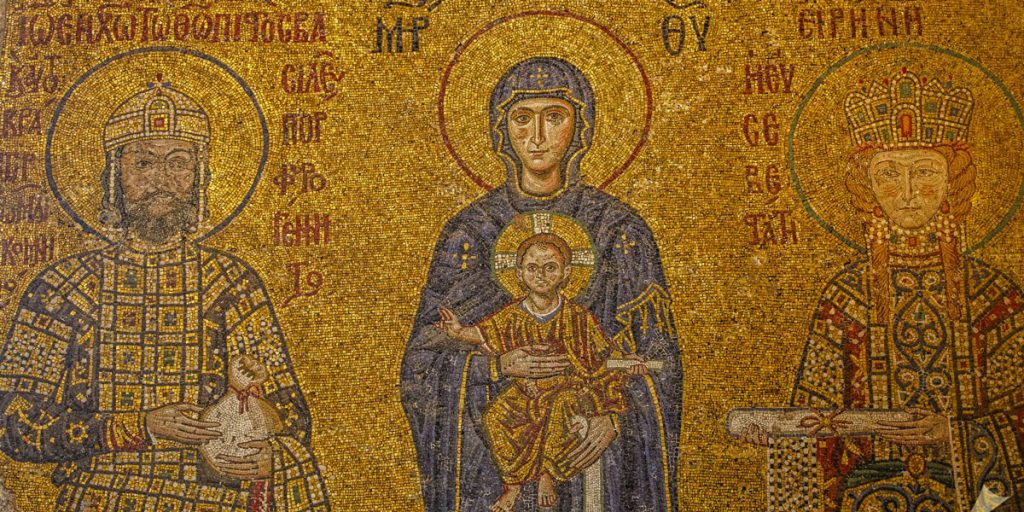
This mosaic is also at the upper south gallery on the east end, near the mosaic of Empress Zoe. It was probably made during the reign of John II Comnenus. Virgin Mary stands in between the Emperor John II Comnenus and his wife Irene. She is holding child Christ. Child Christ is giving his blessings with his right hand while holding a scroll with left. Empress Irene is offering a scroll that symbolizes the donations to the church, and the Emperor is carrying a purse of gold as a symbol of donations to the church.
Deesis
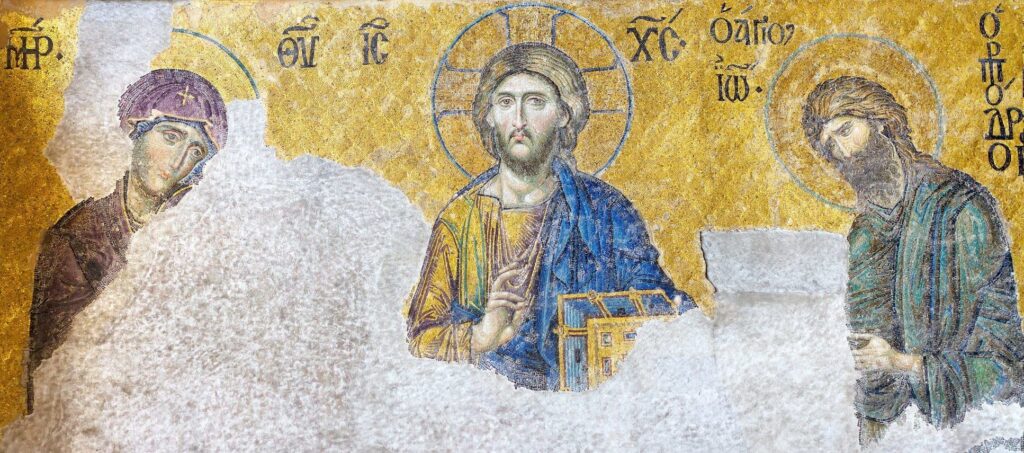
In Byzantine art, a Deesis is a traditional representation of Virgin Mary and Saint John the Baptist, imploring Christ the salvation of man. This mosaic in Hagia Sophia is located in the upper south gallery, dating back to 1261. It is considered to be a pioneer for the Byzantine art in Renaissance period with its soft tones, the intense humanity and the emotional realism on the faces of the figures.
Tombs of Hagia Sophia
There are five tombs belong to Ottoman Sultans and their family members in the historical buildings adjacent to the Hagia Sophia Museum. All restorations done and the buildings could be finally ready to be seen. Normally restorations of historical buildings never end, but particular work should be finished in time. According to Fatih Sultan Mehmet’s testament, Hagia Sophia had to be taken good care of and in recent years his will was fulfilled. Primitive toilets in Hagia Sophia and the scaffolding which has been standing inside for 17 years were removed; the face of the Angel Seraphim mosaic was uncovered; baptistery and the oldest baptism pool were opened to visit, restorations of Sultans’ tombs located in Hagia Sophia’s courtyard were completed. All these works made everybody even the Sultan’s soul satisfied.

The findings which were found during the restorations clarified the sepulchral culture of the Ottomans. All wraps and clothes which were found in tombs are in exhibition and tombs have been covered with the same colour overlays. Although tombs are named after Sultans, tombs were also shelters for the members of their families and their dynasty. It is also known that after Sultan Selim II even the wives were also buried in the same tomb with Sultans.
Tomb of Sultan Mehmet III
The tomb of Mehmet III was built by Architect Dalgic Ahmet Agha and all expenses paid by Ahmet I.
The facade of the building coated with marble and tomb has two domes and octagonal floor plan. Entrance decorations such as flowers, landscape pictures, stars display a style beyond the usual decorations of that period. The windows are laid out in three rows and 17th century white and blue tile decorations stretches horizontally above the lowest row of windows. Hand-drawn ornaments decorate the remaining parts. New sections for the daughters of the sultans were also added on either side of the entrance gate later on. There are also inscriptions about history on the side facing the Bab-i Humayun Street. The tomb building shelters 26 sarcophagi including Sultan Ahmet I’s mother Handan Sultan, sons and daughters of Sultan Ahmet I, daughter of Murat III and other sultans’ sons.
Tomb of Sultan Mustafa I
The structure which is known as the tomb of Sultan Mustafa I and Sultan Ibrahim I was the former baptistery of the basilica and was one of the major annex structures of Hagia Sophia complex. It is covered with a rimless dome and has an octagonal internal layout. Before converted in to a tomb, structure had been used as a storage room for lamp oil for a while in Ottoman period.
Mustafa I who died in 1639, Ibrahim I who died in 1648 are buried here. Including Mustafa I and Ibrahim I, there are a total of 19 sarcophagi in the tomb. Daughters of Ahmet I and daughter of Kaya Sultan of Murat IV, sons and daughters of Ahmet II and some other members of the dynasty are buried in structure.
Tomb of Sultan Selim II
This building is one of the 18 tombs built by Architect Sinan. It has the most beautiful examples of stonework, woodwork, tiles and calligraphic arts. Architect Sinan got an order from Sultan Selim II to build a tomb for him. It is known that the tomb could be completed 3 years after death of Sultan Selim II. The facade of the building is coated with marble. Entrance door of the structure has inlaid mother of pearl which is known as Kundekari Style and decorated with geometrical tortoise shells which is an exclusive example of woodwork. Each side of the door has the tiled panels with purple, blue, green and red flower patterns which show 16th century tile workmanship. Left side of the door has replica tiles which has paler colour than right side ones because original ones were sent to France for restoration in 1895 and they are still in the Louvre Museum.
There are a total 42 sarcophagi in the tomb belong to Sultan Selim II, his wife Nurbanu Sultan, their sons Osman, Mustafa, Suleyman, Cihangir, Abdullah, their daughters Fatma, Istemihan, Hacer and Guherhan and Sultan Murat III’s sons and daughters.
Tomb of Sultan Murat III
The tomb of Sultan Murat III was built by Architect Davud Agha and his assistant Dalgic Ahmet Agha four years after the death of Sultan Murat III in 1595. It is located in between the Princes Tomb and Tomb of Sultan Selim II.
The tomb of Sultan Murat III has hexagon layout, two domes and arched entrance. The facade of the structure is coated with marble. This tomb is accepted as one of the largest Ottoman Tombs. The tomb seems plain from outside but it is very beautiful decorated inside. It has the most beautiful examples of coral red Iznik ceramics dates back 16th century. Hand drawn ornamentation are decorating interior walls. White color polished ceramic tiles on navy blue background create a belt of Celi Sulus style calligraphic decoration inside. Tomb has 3 rows of windows and the lower row windows have wooden kundekari cupboards among themselves. Entrance door of the structure has Kundekari style and it is decorated with mother of pearl inlays. There are total 54 sarcophagi in the tomb belong to Sultan Murat II, his wife Safiye, his daughters and princes and courtier women.
Tomb of Princes
The tomb of Princes has a very plain external view and located nearby the tomb of Sultan Murat II. The structure has a big dome, brick covered floor and limestone covered walls. It seems octagonal from outside but quadrilateral from inside. Entrance of the structure is very well decorated with interlocking wooden laths in geometrical shapes. All interior walls are decorated with plant motifs, hand drawn ornaments, ribbons and flowers in baskets.
In the tomb of Princes 4 princes and the daughter of Sultan Murat III are buried.
